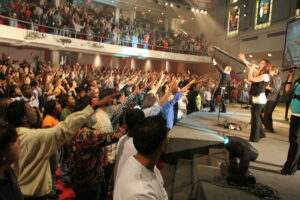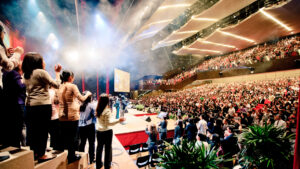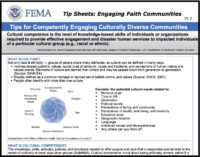In this tip sheet, you will discover foundational information to help you interact with Evangelical Megachurch leaders. It is part of a set of tools and training for FEMA to help disaster response professionals engage with faith communities. Much of the information also can help students, researchers, government agencies, non-profits and businesses learn about and develop relationships with communities. Click here for the PDF version of this tip sheet.
Religion Called: Evangelical Christianity/Evangelicalism or Pentecostalism
Adherents Consider Themselves: Christian and are called Christians, Evangelical Christians or Evangelicals
House of Worship: Church
First Point of Contact: Senior Pastor and governing committee (associate ministers and/or staff)
Religious Leader: Minister/pastor
Spoken Direct Address: Use “Reverend” or “Pastor”
Physical Interaction: Handshakes and hugs generally O.K. across genders
HOUSE OF WORSHIP
Megachurches are large Protestant Christian congregations with an average of 2,000 or more members in attendance for weekly worship. While megachurches are sometimes located in urban areas, many are in high-traffic suburban spaces and often have large-scale campuses with multiple buildings on dozens or hundreds of acres of land. Some have multiple sites.
RELIGIOUS LEADERS
Ordained/Commissioned/Licensed Leaders
- Common terms for megachurch leaders include minister, pastor or reverend.
- Teams of associate ministers usually support the senior minister/pastor.
- Almost all megachurch pastors are male. Some denominations, including most Pentecostal churches, allow for leadership roles for women, although few have assumed leadership of megachurches.
Lay Leaders
- Depending on their size, megachurches may have dozens of full-time staff and/or hundreds or thousands of volunteers.
POINTS OF CONTACT
- Local: Congregations are usually led by a full-time pastor. Some may have an elected governing committee. First point of contact at local level should be both pastor and governing committee.
- Regional: Network, fellowship, association of churches, or denomination (e.g. Calvary Chapel, Southern Baptist, Vineyard).
- National: Network, fellowship, association of churches, or denomination (e.g. Nat’l Assoc. of Evangelicals).
NVOAD MEMBERSHIP AND CORE CAPABILITIES IN DISASTER
Megachurches are likely to have significant financial and human resources including multiple social service programs and ministries (e.g. cash assistance, financial counseling, food pantries). They often have enormous facilities such as parking lots, kitchens, communal spaces, and vehicles. Also common are contemporary audio/visual equipment, a robust online presence (via blogs, podcasts, webcasts), and social media capabilities. These may serve a significant assets during disaster response.
National Voluntary Organizations Active in Disaster (NVOAD) is a nonprofit, nonpartisan, membership based organization that serves as the forum where organizations share knowledge and resources throughout the disaster cycle. FEMA DSA team members should check with their VAL to determine whether local or regional VOADs exist in their operational area. Each organization has distinct capabilities. Responders should check with an organization’s local affiliate or with its national office to confirm capacity and activities specific to each disaster situation.
Evangelical Christian National VOAD members include: ACTS World Relief, Adventist Community Services/Adventist Disaster Response, Billy Graham Rapid Response Team, Convoy of Hope, Cooperative Baptist Fellowship, Feed the Children, HOPE Worldwide, Nazarene Disaster Response, Operation Blessing, Samaritan’s Purse, Southern Baptist Convention Disaster Relief, The Salvation Army, World Renew.
ETIQUETTE QUICK TIPS
Greeting
When introducing yourself to a religious leader, use formal religious titles unless instructed otherwise (Reverend, Pastor, Dr.).
Physical Interaction
Shaking hands and hugging is common in most Evangelical Christian denominations.
Other
- When entering any Protestant house of worship (including a megachurch), shoes are generally left on but men should remove hats or caps. Other than this general practice, traditions around dress codes for both sanctuary spaces and office spaces vary dramatically according to culture and geographical region of the country. In general, there are no rules about what one may wear or not wear, and dress is often casual in many megachurches.
- Ask before participating in worship services. Guests may be invited to participate in some worship activities. If not a member, limit participation in these activities (e.g. taking communion or healings) unless invited. Ushers can help with customs, dress, and etiquette.
- Many Evangelicals believe that Bible study and prayer alone instead of professional medical intervention can overcome mental health concerns. Use discretion when making referrals to mental health service providers.
GOVERNANCE / JUDICATORY
Approximately half of megachurches are non-denominational and half are denominational. Southern Baptist Convention churches make up about 16% of megachurches. When taking into account other networks, fellowships, or associations of churches, the percentage of affiliated megachurches grows to 70%. The remaining 30% are completely free-standing and independent and operate autonomously.
MEETING LOGISTICS AND SCHEDULING
Scheduling and Holidays
Most Evangelicals gather weekly for communal worship involving singing, Bible readings, and a sermon. Many do this on Sunday mornings; a few (e.g. Seventh Day Adventists) meet on Saturday. Many hold mid-week bible study, Saturday and Sunday evening services, and host other events and services throughout the week. Be aware that many pastors take Monday as their day off. Holidays include:
- Christmas: a celebration of the birth of Jesus as God incarnate.
- Holy Week: leads up to Easter; begins with Palm Sunday (recalling Jesus’ return to Jerusalem); includes Maundy Thursday (recalling Jesus’ institution of the practice of Holy Communion during his last meal with his disciples) and Good Friday (recalling Jesus’ crucifixion).
- Easter Season: the most important season in the Christian year celebrating the resurrection of Jesus from the dead.
- Pentecost: commemorating the receipt of the Holy Spirit by the nascent Christian community, fifty days after Jesus’ Resurrection. This holiday is recognized by many and is a major celebration for some.
- All Protestants follow the same liturgical calendar, with varying levels of observance for the seasons of Advent and Lent.
- Some congregations celebrate “Homecoming” (usually late summer; when those who have been away from church return). Some Protestants also observe other days related to their own congregation’s history.
- Thanksgiving Day (a U.S. national holiday) is celebrated as a religious holiday by some Protestant churches.
Food
Few general restrictions or requirements; check with individual leaders. Many Evangelicals choose to avoid alcohol.
Logistics
The scope of many megachurches’ social media followings and contact lists can be helpful in reaching a large number of disaster survivors spread over a wide geographical area.
DRESS
- Many pastors wear attire similar to that of lay members—varies from casual to business casual to “Sunday best” attire.
- Religious leaders with a denominational affiliation may wear clothing prescribed by their denomination or a variety of other ecclesiastical clothes based on personal choice or understanding of their denomination’s historical preferences.
ABOUT EVANGELICAL CHRISTIANITY AND MEGACHURCHES
A megachurch is defined as a church having a large Protestant Christian congregation with an average of 2,000 or more members in attendance for worship each week. Other characteristics often include a charismatic, authoritative senior minister, multiple social and outreach ministries, and a very active congregational community. Eighty-two percent have a majority Caucasian congregation. There are more than 1,600 megachurches in the U.S., with the largest concentrations in California, Texas, and Florida (the largest is Lakewood Church in Houston with an average weekly attendance of 43,500 and annual budget of $70 million).
While approximately 71% of megachurches are Evangelical, as an umbrella term, Evangelicalism covers an enormous diversity of denominations and independent churches. The majority of Evangelicals believe:
- In an assertion of a personal relationship with God through Christ, study of the Bible by laypersons, freedom of conscience on many matters, and a variety in worship styles.
- That Jesus of Nazareth is considered God Incarnate. The birth, ministry, death, and resurrection of Jesus are definitive.
- In a Trinitarian understanding of the nature of God.
- That the Holy Spirit is important to all Evangelicals, but receives more emphasis from Pentecostals who believe in its spiritually renewing gifts such as divine healing, prophesying, and speaking in tongues.
- Many Evangelical churches reserve baptism for adults (or children who are old enough to choose their religion), and may characterize themselves as “Born-Again Christians.”
Click here for the PDF version of this tip sheet.
The Engaging Faith Communities tip sheets were created through a collaboration between the DHS Center for Faith-based and Neighborhood Partnerships, the USC Center for Religion and Civic Culture, USC CREATE and the National Disaster Interfaiths Network. For further training, please see EMI course IS-505, which was also developed by this partnership.



